Polychrome Maya vase rollouts, Museo Popol Vuh, Universidad Francisco Marroquin
The Museo Popol Vuh is one of the largest collections of Maya vases, plates, bowls, figurines, burial urns, cache vessels, and incensarios which are in true authentic condition. Most other museum collections have vases, plates, and bowls which have been repainted under the pretense of “restoration.” But the repainting was done with modern paint to make the vases look bright and pretty in order to have dubious evaluations for tax deductions.
Another museum which sets a good record for authentic Maya ceramic art is the National Museum of Archaeology and Ethnology, Guatemala City (near the airport).
The Castillo Bowl is an excellent example of a Late Classic Maya polychrome painting which is in pristine condition. I first photographed this vase in the 1990’s and fortunately it has never been “restored.”
Although I call it a bowl (because the diameter is much wider than the height), in reality the scene is what you would expect on a series of Mayan vases of the same period. Vases are common during Tepeu 1 and Tepeu 2 times. I estimate this painting is Tepeu 2 time period, Late Classic.
The subsequent Tepeu 3 century is the time of the collapse of the traditional styles and the collapse of most of the city-states.
Rollouts help facilitate the study of iconography and art
In the 1990’s I had studied several vases which showed decapitation. Most of these vases either themselves also showed dancers or were similar in style to vases and bowls which showed ritual dancers. So by the late 1970’s I had already nicknamed these the Dance after Decapitation Death.
|
This is a digital rollout using a Dicomed version of the Better Light tri-linear scanner; 4x5 camera, Schneider or Rodenstock macro lens; Gitzo tripod.
|
|---|
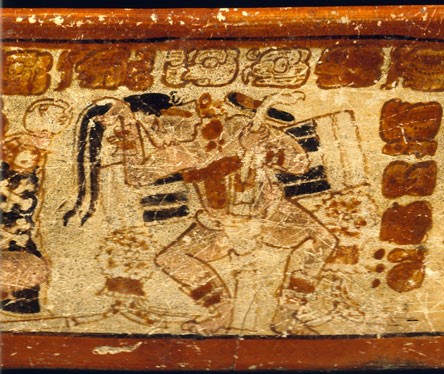 |
|---|
|
This person is wearing the identical back-decoration outfit as the skeleton later in the scene. |
|
This personage is similar but not identical to the person holding the heart-sacrificed baby. So this lends a bit more suggestion that both are male. |
|---|
|
This partially skeletonized jaguar has a large enema syringe (cluster) in his forward hand and the typical “enema jug” in his other hand. Michael Coe was the iconographer who first identified enema iconography. I found many more scenes of enemas and my comments on these were included in a PhD level dissertation by a scholar in Europe. It is an honor to have a student put my material inside their thesis or dissertation as an appendix or comparable. You can download this on www.ncbi.nlm.nih.gov/pubmed/3528674. |
|---|
|
This area of the scene is as much a study in epigraphy in addition to iconography. I have photographs of two other vases showing segments of the same scene as the Castillo Bowl. However the Castillo Bowl has nine segments; the other two polychrome painted pots show fewer. |
|---|
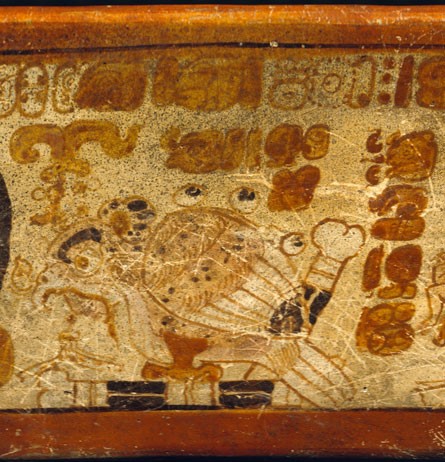 |
|---|
|
The giant raptor has an idealized human head in its mouth. Whether the bird is vomiting out the head of a dead person, or ingesting it, should be studied. |
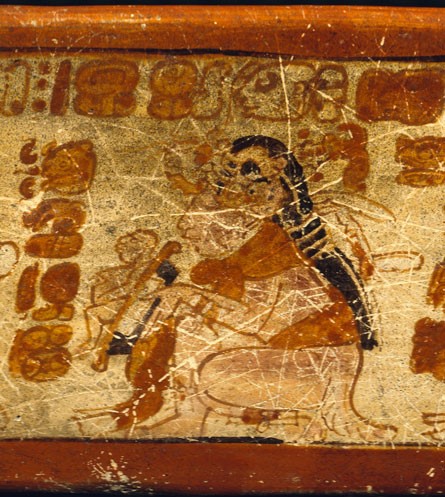 |
|---|
|
It would be helpful to identify whether this is a man or a woman. The face is very similar to idealized men in Maya scenes, though the hair is a bit long. We can’t see the breast area because it is covered with the person’s arms. The v-shaped hole in the baby’s chest is where its heart has been cut out. Sacrificing babies was an unfortunate aspect of most “civilizations” of Mesoamerica, and probably painfully common in many other cultures around the world. The actual skeletons of these sacrificed babies are found by archaeologists in caves or under temples or other structures. |
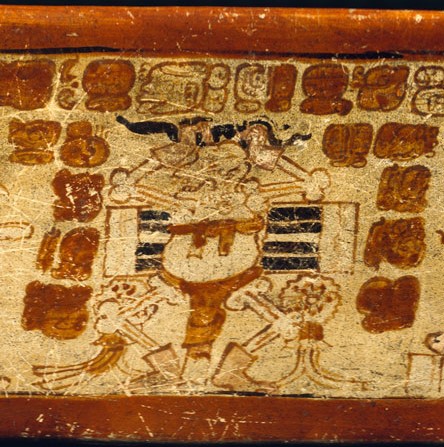 |
|---|
|
This skeletal character seems to have either a bad case of dandruff or a “bad hair day.” There are several skeletal deities shown in Late Classic Maya vases, bowls, and plates. Most of them are similar to the deities, demons, and devils of Xibalba of the Popol Vuh. The horizontal item tied around the skeleton’s back has the same black-white-black pattern as the bones under and behind the jaguar. The same design concept can be found on other Mayan vases. |
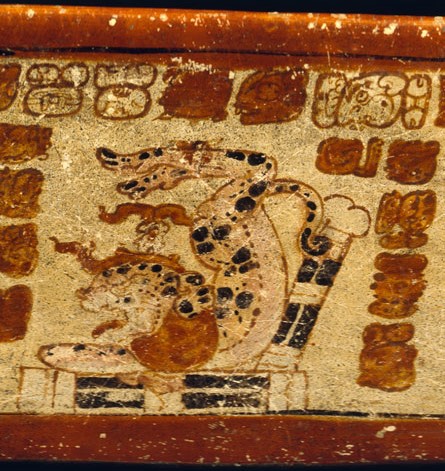 |
|---|
|
I have always estimated that the Classic Mayan kings and high priests had trained pet jaguars in their courts. Jaguars are relatively easy to train; Photographer Dicky Mata (brother of Dr Billy Mata, first president of the Museo Popol Vuh) had a pet jaguar; he used to carry the full-grown jaguar on his shoulders. |
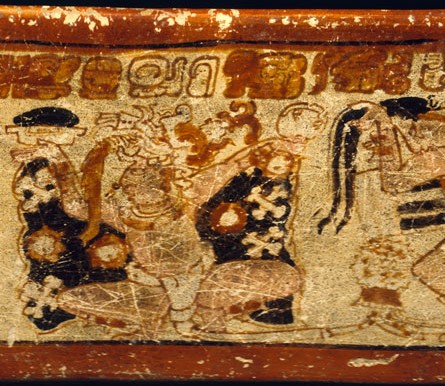 |
|---|
|
Camazotz of the Popol Vuh, what I call the Slicer Bat. Several Chama vases show the Camazotz, as do Lowland Maya polychrome plates and vases. Plus there is one bat sculpture in the Museo Popol Vuh and a larger bat sculpture in the Copan Sculpture Museum, Copan Ruinas, Honduras. The crossed-bones are common on several other bat personages. Would be helpful to know if these are animal bones or stylized human bones. |
MUSEO POPOL VUH, Guatemala City
This and associated pages feature iconographic information and Images of pre-Columbian Maya art from the Museo Popol Vuh. We did photography in this nice museum in the 1990’s and a few years after that also.
The purpose of this section of the FLAAR Maya archaeology web sites is to draw attention to the museums of Guatemala to encourage more people to visit them.
|
Map showing the location of the Museo Popol Vuh and Museo Ixchel on the campus of UFM (Universidad Francisco Marroquin) |
|---|
The Museo Popol Vuh is located on the campus of the private university, Universidad Francisco Marroquin (UFM). The Museo Ixchel (of textiles) is in the same building complex at this university. So you can visit two nice museums in one single trip.
 |
|---|
To appreciate the genius of the Classic Maya artists and scribes, a visit to the Museo Popol Vuh is essential. Although 90% of the visitors to Guatemala visit Antigua or Chichicastenango, and perhaps 50% visit Tikal, too few reach the museums. So we at FLAAR encourage you to add museums to your schedule while in Guatemala.
The exhibits are well designed in a modern manner. The building is new and looks suitably impressive. The exhibits include a colorful display of animals in Maya art. In addition to pre-Columbian art, the museum has a really nice selection of Spanish colonial art.
Ritual suicide pictured in a death dance of nagual, way animal spirit companions, on a precolumbian polychrome ceramic from the Tikal area, Guatemala.
The library of Dr Nicholas Hellmuth is on long-term loan to the Museo Popol Vuh
Dr Nicholas has provided the Museo Popol Vuh his personal library on Mayan art, iconography, and archaeology on open-ended long-term loan for over 30 years. We felt these tons of books would be helpful to the students who visit the library, to the museum staff, and to visiting professors and students from other countries.
For about four or five years Dr Nicholas was a visiting research professor at UFM, and prior to that Nicholas worked as a volunteer at the museum for many years. Because of the hospitality of the UFM and MPV boards of directors and staff, Nicholas has provided his personal library on loan for many decades.
Other Museums in Guatemala worth Visiting
We recommend visiting
La Aurora Zoo (near the airport). Zoológico La Auroa.
www.aurorazoo.org.gt
Museo Nacional de Historia Natural (also near the airport; a few meters from the museum of archaeology). National Museum of Natural History.
http://mcd.gob.gt/museo-nacional-de-historia-natural/?lang=en
Museo Nacional de Arqueología y Etnología (MUNAE), National Museum of Archaeology and Ethnology, of IDAEH, near the airport, across a parking lot from the Museo Nacional de Historia Natural.
http://munae.gob.gt/pages/museo.php?lang=ES
Museo de Historia Natural de la Universidad de San Carlos, on one side of the nice botanical garden.
www.facebook.com/MuseoDeHistoriaNaturalDeLaUsacMusnat/
Jardín Botánico de Guatemala, also known as Jardín Botánico de la Universidad de San Carlos. A nice botanical research garden; mostly outside (so not greenhouses as needed in USA and Europe).
http://sitios.usac.edu.gt/jardinbotanico/
This page was first posted so many years ago we don't have the exact date any more.































